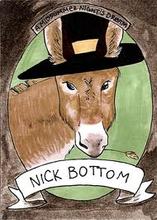"So quick bright things come to confusion"  …was the overall feeling of the class after stepping into "A Midsummer Night's Dream" this week. Sub-plots and spells, dreams and potions, all seemed to have our heads spinning by the time we finished up for the day. Even the homework assignment proved challenging for some of our Shakespearean researchers. But it was great to read through all the collected data and compare notes with each other's findings. The highlight of the research was in one of the final questions, "What is The Authorship Debate?" This brought a whole new light to the mystery that surrounds William Shakespeare and the conspiracy theories that have circulated regarding his works. Questions that arose from the students were, "How can we name someone if he doesn't exist?", "How can he have a date of birth or death?" You could almost sense the disappointment that there was even a question about a name we have come to know so well -- "What do you mean William Shakespeare may not exist?" -- as if the rug had been pulled out from under them. It made for some great inquisitive thoughts and dialogue. Please use the above link provided to explore this issue further, especially if your student was intrigued by the subject matter! Warming up to (Mid)Summer We then opened the door to our new reader's theatre play, "A Midsummer Night's Dream." Students were read a brief description and synopsis of the play as they followed along with a character map of all the players. This helped give them an overview of the sub-plots and how they all come together in the end. We then got up on our feet to warm up our line readings and start to "wear" who's who in the play. Each student was given four lines from the play to read and study for a few moments. As a "director's script" synopsis of the play was read aloud to them, each student was asked to step into the middle of the circle and read aloud the assigned lines when it was his/her turn. Something very interesting happens when Shakespeare's lines are taken out of their dialogue context, making for some very humorous line readings! For instance, this line in the play, "I am such a tender ass, if my hair do but tickle me, I must scratch." You can imagine the uproar and silliness that ensued after that line reading! But after the humor waned and the line was further dissected one realized its meaning -- spoken by Nick Bottom a seasoned actor in the play who was made victim of a spell that manifested itself in the form of a Donkey's head upon his own. Upon realizing the excessive growth of hair he suddenly gained, he stated the above line which really means ("I think I have an awful lot of hair on my face, and I am such a sensitive donkey, that I must scratch even if my hair only tickles me a little!).  After the warm-up, we dove right into our first script reading and found ourselves getting a bit tongue tied. I reminded students that this was also the case when we read our Hamlet scripts for the first time and that it will come with time, and practice. It was interesting to hear how line readings were interpreted to fit our natural language flow today. For instance, "I had no judgement when to her I swore" was mis-read "I had no judgement when I swore to her." Naturally it feels easier rolling off our 21st century tongues with the second line reading, but this is the challenge we face with Shakespeare and his poetic 16th century style. It is a wonderful exercise in language and we are diving right in and mastering it! For next week... For homework…practice, practice, practice your lines so they start to become more effortless. Highlight your part(s) in your script, look over your Facts & Character Map Handout, and take 25 minutes to watch this simplified version of the play from "Shakespeare Animated Tales" to help orient yourself with the characters and the flow of the play. Have a great week! Comments are closed.
|
Categories
All
Archives
May 2016
|

 RSS Feed
RSS Feed